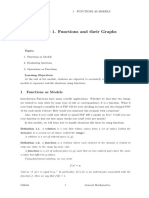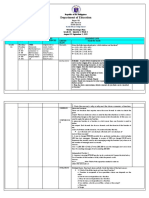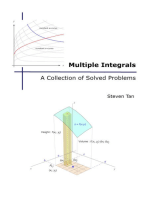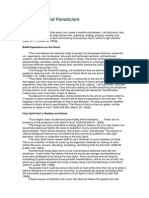Handouts Chapter 1 Functions
Uploaded by
Kianna DomingoHandouts Chapter 1 Functions
Uploaded by
Kianna DomingoGeneral Mathematics – Chapter 1: Functions
Lesson I: FUNCTIONS AS MODELS Vertical Line Test – a graph represents a function
if and only if each vertical line intersects the
Lesson Outlines:
graph at most once.
Functions and Relations
Vertical Line Test a.) b.)
Representing real-life situations functions,
including piecewise functions.
Relation – a rule that relates values from a
set of values (called the domain) to a second
set of values (called the range). b.) d.)
Is a set of ordered pairs (x,y).
Function – is a relation where each element in
the domain is related to only one value in the
range by some rule
using functional notation, we can write f(x) =
y, read as “f of x is equal to y”.
e.)
Example 1. Which of the following relations are
functions?
f = {(1,2), (2,3), (3,5), (4,7)}
g = {(1,3), (1,4), (2,5), (2,6), (3,7)}
h = {(1,3), (2,6), (3,9),…,(n,3n),..}
Solution: Solution:
The relations f and h are functions because no Graphs a, b, and e are graphs of functions while
two ordered pairs have the same x-value but different b and d are not because they do not pass the vertical
y-values. Meanwhile, g is not a function because (1,3) line test.
and (1,4) are ordered pairs with the same x-value but
different y-values. Example 4. Identify the domain for each relation using
set builder notation.
Example 2. Which of the following mapping diagrams
represent functions? a. y = 2x + 1
b. x2 + y2 = 1
f h c. y = √ x+1
2 x +1
d. y =
x−1
e. y = x2 – 2x + 2
Solution:
a. {x : x ∈ R} d. {x: x ∈ R, x ≠ 1}
b. {x: x ∈ R, -1 ≤ x ≤ 1} e. {x : x ∈ R}
g
c. {x: x ∈ R, x ≥ -1}
Functions as representations of real-life situations.
Example 5. Which of the following is a function?
1. Student to his/her LRN.
2. A washing machine to its uses.
3. A school to his/her teachers.
Solution:
The relation f is a function because each value Solution:
of the outputs is unique for a specific value of x. The 1. Function, because every student has only
relations h and g are not functions because there is at one LRN.
least one element in x for which there is more than one
corresponding y-value.
1
General Mathematics – Chapter 1: Functions
2
2. Not a function, because every washing x +5 x−3
machine has many uses (washing, drying, (e) m(x) = 2
2 x +3 x+15
etc)
Solution: Substituting 3 for x in the functions above,
3. Not a function, because every school has
we have
more than one teacher.
(a) f(3) = 2(3) + 1 = 6 + 1 = 7
Example 6. Give a function C that can represent the cost
(b) q(3) = 32 – 2(3) + 2 = 9 – 6 + 2 = 5
of buying x meals, if one meal costs P40.
(c) g(3) = √ 3+1 = 4 or -4
Solution: Since each meal costs P40, then the cost 2(3)+ 1
(d) r(3) =
function is C(x) = 40x. 3−1
2
3 +5(3)−3 21 1
Example 7. A person can encode 1000 words in every (e) m(3) = = =
2(3) +3 (3)+ 15 42 2
2
hour of typing job. Which of the following expresses the
total words W as a function of the number of hours that
Example 2. Evaluate the following functions, where f
the person can encode?
and q are as defined in Example 1.
Solution: W(h) = 1000h
(a) f(3x – 1) (b) q(2x + 3)
Piecewise function- is a function built from
pieces of different functions over different Solution:
intervals.
(a) f(3x – 1) = 2 (3x – 1) + 1 = 6x – 2 + 1 = 6x -1
(b) q(2x + 3) = (2x + 3)2 – 2(2x + 3) + 2
Example 8. A user is charged P300 monthly for a
= (4x2 + 12x + 9) -4x -6 + 2
particular mobile plan, which includes 100 free text
= 4x2 + 8x + 5
messages. Messages in excess of 100 are charged P1
each. Represent the monthly cost for text messaging
Example 3: Given
using the function t(m), where m is the number of
{
2
messages sent in a month. 9−x , x <2
f(x) = √ x +7 , 2 ≤ x <10
Solution: The cost of text messaging can be expressed ¿ x−4∨, x ≥ 10
by the piecewise function. give the values of the following:
t ( x )=
{300+(m−100)
300 , if 0< m≤ 100
,∧if m>100
(a) f(2)
(b) f(12.5)
(c) f(-3)
Example 9. A jeepney ride costs P10.00 for the first 4
kilometers, and each additional integer kilometer adds Solution:
P1.50 to the fare. Use a piecewise function F(d) to
represent the jeepney fare in terms of the distance (d) (a) f(2) = √ 2+7 = 3 or -3
in kilometers. (b) f(12.5) = |12.5 – 4| = 8.5
(c) f(-3) = 9 – (-3)2 = 0
F (d )=
{10+1.510(d−4)
,if 0<d ≤ 4
,∧if d> 4
PRACTICE!
Lesson II: EVALUATING FUNCTIONS
1. Evaluate the following functions at x = 2.
Lesson Outlines:
(a) f(x) = x – 3
Evaluating functions (b) g(x) = x2 – 3x + 5
(c) h(x) = √3 3
x + x +3
2
x +1
Evaluating a function means replacing the (d) p(x) =
x−4
variable in the function, in this case x, with a
x 2+ 3 x−5
value from the function’s domain and (e) r(x) =
computing for the result. 3 x 2 +4 x−5
2. Evaluate f(a + b) where f(x) = 4x2 – 3x.
Example 1. Evaluate the following functions at x = 3:
3. A computer shop charges P20.00 per hour (or a
(a) f(x) = 2x + 1 fraction of an hour) for the first two hours and
(b) q(x) = x2 – 2x + 2 an additional P10.00 per hour for each
(c) g(x) = √ x+1 succeeding hour. Find how much would you
2 x +1 pay if you used one of their computers for:
(d) r(x) =
x−1 (a) 40 minutes
2
General Mathematics – Chapter 1: Functions
(b) 3 hours
(c) 150 minutes x 2 +5 x+ 4 ( x+ 4 )( x +1 )
e. (v / g)(x) = 2 = =
x +2 x−8 ( x+ 4 )( x−2 )
x+ 1
x−2
2 2
Lesson III: OPERATIONS ON FUNCTIONS x −4 x−5 x −5 x+ 6
f. (a ∙ b)(x) = ( 2
¿∙ 2
x −3 x +2 x −3 x−10
Lesson Outlines:
Addition, subtraction, multiplication, and
(x +1)(x−5) ( x−2)(x−3)
= ∙
division of functions ( x−2)(x−1) ( x−5)(x +2)
Function composition ( x +1)( x−3)
=
( x−1)(x +2)
2 2
Definition. Let f and g be functions. 2 x + x −6 x −2 x−8
g. (c / d)(x) = 2 ÷ 2
2 x +7 x+5 2 x −3 x−20
1. Their sum, denoted by f + g, is the function
denoted by (f + g) (x) = f(x) + g(x) 2 x 2+ x −6 2 x 2−3 x−20
2. Their difference, denoted by f – g, is the = ∙
2 x 2 +7 x+5 x 2−2 x−8
function denoted by (f – g)(x) = f(x) – g(x).
3. Their product, denoted by f ∙g, is the function
denoted by (f∙ g)(x) = f(x) ∙ g(x) (2 x−3)( x+ 2) ( x−4)(2 x+5)
= ∙
(2 x +5)( x+1) ( x +2)(x −4)
4. Their quotient, denoted by f/g, is the function
denoted by (f / g)(x) = f(x) / g(x)
2 x−3
Use the following below for Example 1. =
x+1
f(x) = x +3 p(x) = 2x – 7
v(x) = x2 + 5x + 4 g(x) = x2 + 2x -8 Definition. Let f and g be functions. The composite
x+7 x−2 function denoted by (f o g) is defined by (f o g)(x) =
h(x) = t(x) = f(g(x)). The process of obtaining a composite function
2−x x+3
2 2 is called function composition.
x −4 x−5 x −5 x +6
a(x) = 2 b(x) = 2
x −3 x +2 x −3 x −10
2 x 2+ x −6 x 2−2 x−8 (Use the given functions used in Example 1)
c(x) = d(x) =
2 x 2 +7 x+5 2 x 2−3 x−20
Example 2.
Example 1. Determine the following functions.
(a) (f o p)(x) = f(p(x))
f(2x-7) = x + 3
a. (v + g)(x) f(2x-7) = (2x – 7) + 3
b. (f ∙ p)(x) f(2x-7) = 2x – 4
c. (f + h)(x)
d. (p – f)(x) (b) (p o f)(x) = p(f(x))
e. (v / g)(x) p(x+3) = 2x – 7
f. (a ∙ b)(x) p(x+3) = 2(x+3) – 7
g. (c / d)(x) p(x+3) = 2x + 6 – 7
p(x+3) = 2x – 1
Solution:
(c) (p o g)(x) = p(g(x))
p(x2 + 2x -8) = 2x – 7
a. (v + g)(x) = (x2+5x+4)+(x2+2x-8)
p(x2 + 2x -8) = 2(x2 + 2x -8) – 7
= 2x2 + 7x – 4 p(x2 + 2x -8) = 2x2 + 4x – 16 -7
b. (f ∙ p)(x) = (x+3)(2x-7) = 2x2 – x – 21 p(x2 + 2x -8) = 2x2 4x – 23
x+7
c. (f + h)(x) = (x+3) + =
2−x PRACTICE!
( x +3)(2−x )+(x +7)
=
2−x 1. Let f(x) = 3x2 – 2x – 1, g(x) = x2 – 1, and h(x) =
2
2 x +6−x −3 x+ x +7 f(x) + g(x). Find:
= (a) (f – g)(x)
2−x
2 (b) f(-1) ∙ g(2) ∙ h(0)
−x +13
= (c)
g ( x)
2−x
f (x)
d. (p – f)(x) = (2x – 7) – (x + 3) = 2x – 7 – x – 3
= x – 10 (d) h ( x−1 )
(e) f(3) + g(2)
3
General Mathematics – Chapter 1: Functions
2. Let f(x) = 2x – 15, g(x) = x2 + 19x + 90, h(x) =
√ x+ 6. Find:
(a) ( g o f)(x)
(b) (h o g)(-4)
(c) f(f(f(f(15))))
You might also like
- M O D U L E S L E A R N I N G Grade 11: General MathematicsNo ratings yetM O D U L E S L E A R N I N G Grade 11: General Mathematics9 pages
- 1 2 - Represent Real Life Situations - Evaluating - FunctionsNo ratings yet1 2 - Represent Real Life Situations - Evaluating - Functions29 pages
- Lesson Week 1. Relation Functions Operations and Word ProblemsNo ratings yetLesson Week 1. Relation Functions Operations and Word Problems60 pages
- Topic:: Understanding Function and RelationNo ratings yetTopic:: Understanding Function and Relation28 pages
- Module 1 - Week 1 - Quarter 1 - Gen MathNo ratings yetModule 1 - Week 1 - Quarter 1 - Gen Math12 pages
- General Mathematics Semi Detailed Lesson Plan Week 1No ratings yetGeneral Mathematics Semi Detailed Lesson Plan Week 112 pages
- F ( (1,2), (2,3), (3,4), (4,5) ) H ( (1,2), (2,2), (3,4), (4,4) ) G ( (1,3), (1,4), (2,5), (2,6), (3,7) ) I ( (1,3), (2,6), (3,9),, (N, 3 N), )100% (1)F ( (1,2), (2,3), (3,4), (4,5) ) H ( (1,2), (2,2), (3,4), (4,4) ) G ( (1,3), (1,4), (2,5), (2,6), (3,7) ) I ( (1,3), (2,6), (3,9),, (N, 3 N), )29 pages
- General Mathematics Lesson Plan July 29 - August 1,2024No ratings yetGeneral Mathematics Lesson Plan July 29 - August 1,20248 pages
- Revisiting Functions: Lesson DescriptionNo ratings yetRevisiting Functions: Lesson Description11 pages
- Queen Anne School: General Mathematics Week 1No ratings yetQueen Anne School: General Mathematics Week 18 pages
- Weekly Prototype Plan Week 1 General MathematicsNo ratings yetWeekly Prototype Plan Week 1 General Mathematics9 pages
- Leading the Way in Financial Excellence: M&M AL MENHALI AUDITING, Dubai's Top Accounting FirmNo ratings yetLeading the Way in Financial Excellence: M&M AL MENHALI AUDITING, Dubai's Top Accounting Firm7 pages
- Process Mapping and Value Stream MappingNo ratings yetProcess Mapping and Value Stream Mapping24 pages
- Construction Project Schedule Template G1 Residential BuildingNo ratings yetConstruction Project Schedule Template G1 Residential Building4 pages
- The Demonic King Chases His Wife - Chapter 351-400No ratings yetThe Demonic King Chases His Wife - Chapter 351-400119 pages
- Motivation and Motivational Theory Theories (Industrial Management)100% (8)Motivation and Motivational Theory Theories (Industrial Management)12 pages
- Lexber Inc. V Sps. Dalman G.R. No. 183587, April 20, 2015No ratings yetLexber Inc. V Sps. Dalman G.R. No. 183587, April 20, 201514 pages
- Bank Frauds and Role of RBI - Taxguru - inNo ratings yetBank Frauds and Role of RBI - Taxguru - in3 pages
- CE8394 Fluid Mechanics and Machinery MCQNo ratings yetCE8394 Fluid Mechanics and Machinery MCQ39 pages
- PDF Instruction On Enabling Chinese Font and Typing CharactersNo ratings yetPDF Instruction On Enabling Chinese Font and Typing Characters18 pages
- Account Statement: Tizar Infra Projects Private Limited NO. 95 Palayam Bazaar Woraiyur TiruchirappalliNo ratings yetAccount Statement: Tizar Infra Projects Private Limited NO. 95 Palayam Bazaar Woraiyur Tiruchirappalli2 pages
- M O D U L E S L E A R N I N G Grade 11: General MathematicsM O D U L E S L E A R N I N G Grade 11: General Mathematics
- 1 2 - Represent Real Life Situations - Evaluating - Functions1 2 - Represent Real Life Situations - Evaluating - Functions
- Lesson Week 1. Relation Functions Operations and Word ProblemsLesson Week 1. Relation Functions Operations and Word Problems
- General Mathematics Semi Detailed Lesson Plan Week 1General Mathematics Semi Detailed Lesson Plan Week 1
- F ( (1,2), (2,3), (3,4), (4,5) ) H ( (1,2), (2,2), (3,4), (4,4) ) G ( (1,3), (1,4), (2,5), (2,6), (3,7) ) I ( (1,3), (2,6), (3,9),, (N, 3 N), )F ( (1,2), (2,3), (3,4), (4,5) ) H ( (1,2), (2,2), (3,4), (4,4) ) G ( (1,3), (1,4), (2,5), (2,6), (3,7) ) I ( (1,3), (2,6), (3,9),, (N, 3 N), )
- General Mathematics Lesson Plan July 29 - August 1,2024General Mathematics Lesson Plan July 29 - August 1,2024
- Multiple Integrals, A Collection of Solved ProblemsFrom EverandMultiple Integrals, A Collection of Solved Problems
- Leading the Way in Financial Excellence: M&M AL MENHALI AUDITING, Dubai's Top Accounting FirmLeading the Way in Financial Excellence: M&M AL MENHALI AUDITING, Dubai's Top Accounting Firm
- Construction Project Schedule Template G1 Residential BuildingConstruction Project Schedule Template G1 Residential Building
- The Demonic King Chases His Wife - Chapter 351-400The Demonic King Chases His Wife - Chapter 351-400
- Motivation and Motivational Theory Theories (Industrial Management)Motivation and Motivational Theory Theories (Industrial Management)
- Lexber Inc. V Sps. Dalman G.R. No. 183587, April 20, 2015Lexber Inc. V Sps. Dalman G.R. No. 183587, April 20, 2015
- PDF Instruction On Enabling Chinese Font and Typing CharactersPDF Instruction On Enabling Chinese Font and Typing Characters
- Account Statement: Tizar Infra Projects Private Limited NO. 95 Palayam Bazaar Woraiyur TiruchirappalliAccount Statement: Tizar Infra Projects Private Limited NO. 95 Palayam Bazaar Woraiyur Tiruchirappalli

























































































